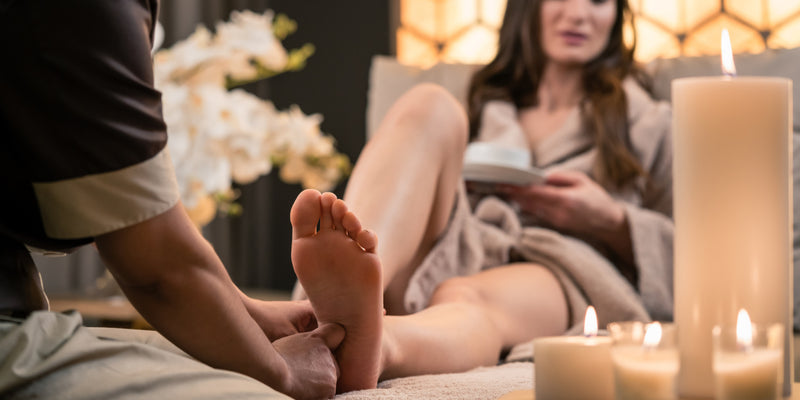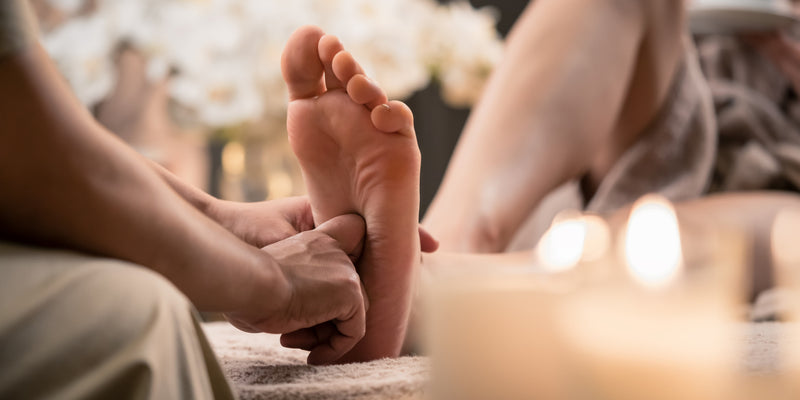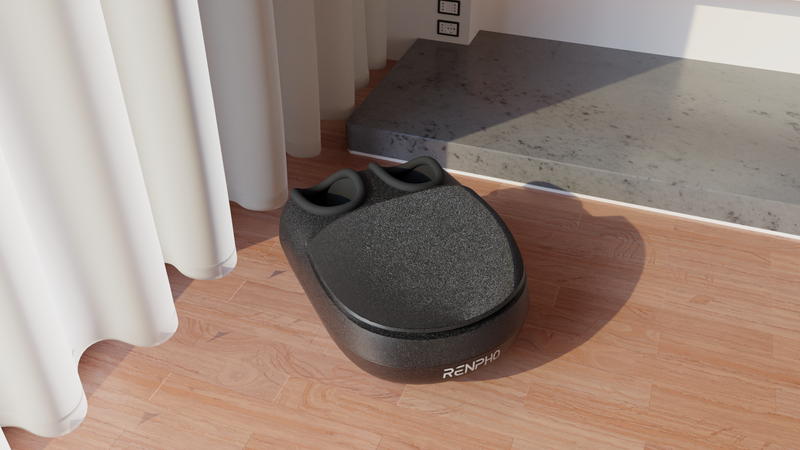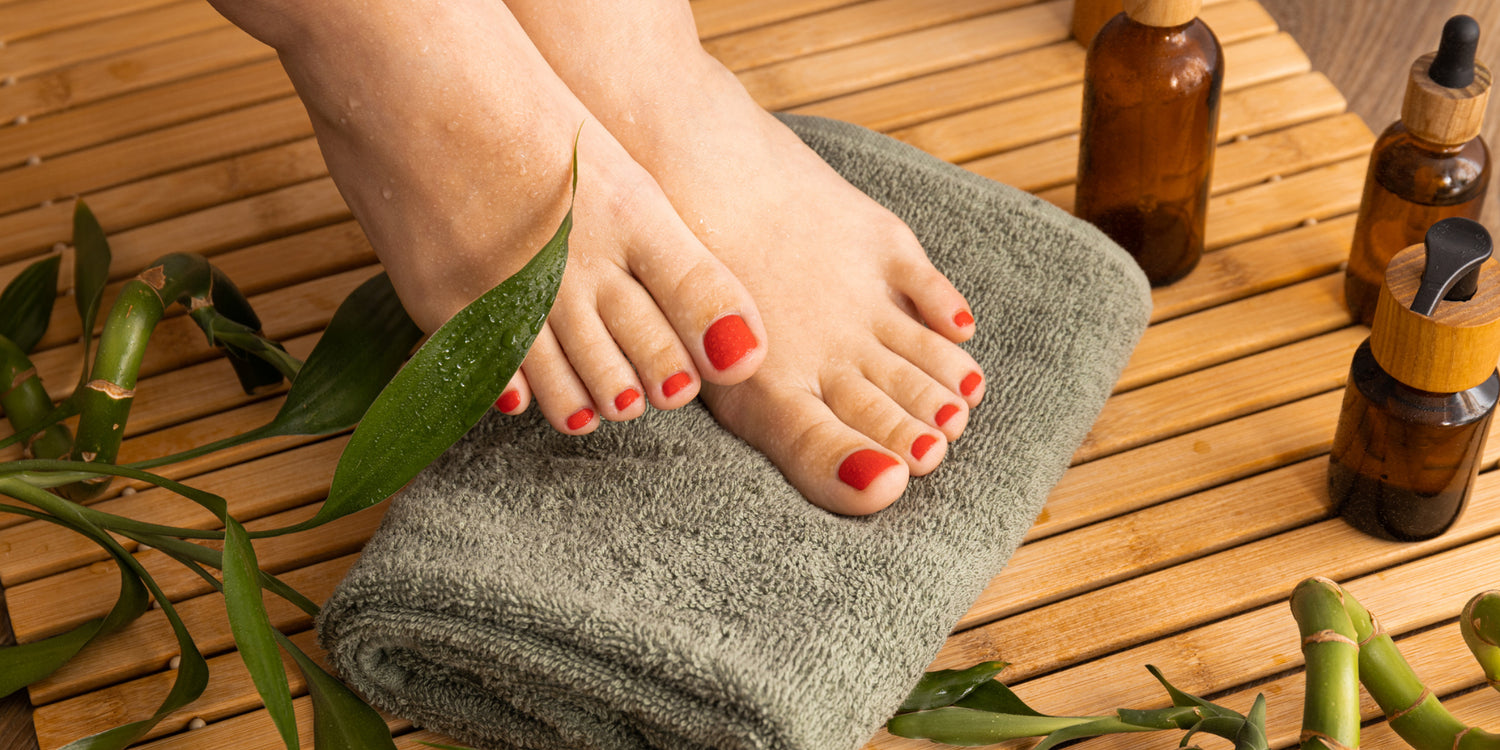Egal, ob Sie ein erfahrener Wanderer sind oder den Großteil Ihres Lebens im Sitzen verbringen, die richtige Fußpflege ist für die Gesundheit und Freude Ihrer Füße unerlässlich. Schließlich tragen unsere Füße das Gewicht unseres gesamten Körpers und bringen uns überall hin, wo wir hin müssen. Ihre Vernachlässigung kann zu Unbehagen, Schmerzen und später sogar zu ernsteren Problemen führen.
Aber keine Sorge, wir erklären Ihnen das ABC der Fußhygiene und geben Ihnen praktische Tipps, wie Sie Ihre Füße in Topform halten. Lassen Sie uns diese Reise gemeinsam antreten und die Geheimnisse einer optimalen Fußhygiene entdecken.
Warum ist Fußhygiene wichtig?

Fußhygiene ist ein entscheidender Aspekt der Körperpflege, der oft übersehen wird. Unsere Füße sind ständig mit unterschiedlichen Oberflächen in Kontakt, Feuchtigkeit ausgesetzt und über lange Zeit im Schuhwerk eingeschlossen. Dadurch können sie zu Brutstätten für Bakterien und Pilze werden, was zu zahlreichen fußbezogenen Problemen führen kann. Die richtige Fußhygiene ist wichtig, um unsere Füße gesund zu halten, die allgemeine Hygiene aufrechtzuerhalten und Infektionen vorzubeugen.
Was passiert, wenn Sie die richtige Fußpflege vernachlässigen?
Die Vernachlässigung der richtigen Fußpflege kann verschiedene Folgen und mögliche gesundheitliche Komplikationen nach sich ziehen. Wenn Sie Ihrer Fußpflege nicht genügend Aufmerksamkeit schenken, kann dies zu Schmerzen, Unwohlsein und eingeschränkter Beweglichkeit führen. Darüber hinaus kann es zu ernsteren Problemen führen.
Eine der unmittelbaren Folgen einer vernachlässigten Fußpflege ist die Bildung von Schwielen, Hühneraugen und Blasen. Diese können schmerzhaft sein und die Gehfähigkeit einschränken. Eine weitere häufige Folge sind eingewachsene Zehennägel, die unbehandelt Schmerzen, Infektionen und Schwierigkeiten beim Gehen verursachen können.
Eine über einen längeren Zeitraum vernachlässigte Fußpflege kann zu schwerwiegenderen gesundheitlichen Problemen führen. Unbehandelte Fußerkrankungen können zu Folgendem führen: chronische Fußschmerzen, was körperliche Aktivitäten erschwert und sich negativ auf die allgemeine Lebensqualität auswirkt. Darüber hinaus können Fußprobleme das Gleichgewicht beeinträchtigen und das Sturzrisiko erhöhen, insbesondere bei älteren Menschen.
Auch eine vernachlässigte Fußpflege kann zur Entstehung von Infektionen beitragen. Kleinere Schnitte, Blasen oder Geschwüre können sich infizieren, wenn sie nicht richtig gereinigt und gepflegt werden. Bleiben diese Infektionen unbehandelt, können sie sich ausbreiten und möglicherweise zu Zellulitis, Abszessen oder sogar einer Sepsis führen.
Eine rechtzeitige Behandlung von Fußproblemen ist unerlässlich. Durch die sofortige Inanspruchnahme medizinischer Hilfe und eine gute Fußhygiene können Sie potenziellen Komplikationen vorbeugen, die auf eine vernachlässigte Fußpflege zurückzuführen sind. Um ernsthafte Komplikationen zu vermeiden, sind regelmäßige Kontrollen der Füße auf Veränderungen, die Einhaltung der richtigen Hygiene, das Tragen bequemer und gut sitzender Schuhe sowie die Inanspruchnahme professioneller Hilfe bei Fußproblemen entscheidend.
Was ist das ABC der Fußhygiene?

Fußhygiene ist wichtig, um gesunde Füße zu erhalten und verschiedenen Fußproblemen vorzubeugen. Durch Befolgen des ABCs der Fußhygiene können Sie sicherstellen, dass Ihre Füße sauber, angenehm und frei von Infektionen bleiben. Diese einfachen und praktischen Schritte lassen sich leicht in die tägliche Routine integrieren und tragen zur allgemeinen Fußgesundheit und zum Wohlbefinden bei. Vom gründlichen Waschen und Trocknen der Füße bis hin zur Wahl des richtigen Schuhwerks ist die Einhaltung der richtigen Fußhygiene von entscheidender Bedeutung, um Problemen wie Fußpilz, Nagelpilz und Geruchsbildung vorzubeugen. Durch das Verstehen und Anwenden des ABCs der Fußhygiene können Einzelpersonen proaktive Schritte zur Pflege ihrer Füße unternehmen und sich einer optimalen Fußgesundheit erfreuen.
A steht für geeignetes Schuhwerk
Wenn es um die Pflege unserer Füße geht, ist nichts wichtiger als das Tragen geeigneter Schuhe. Es bietet nicht nur Komfort und Halt, sondern spielt auch eine wichtige Rolle beim Schutz unserer Füße und der Vorbeugung von Verletzungen.
Bei der Auswahl der richtigen Schuhe müssen mehrere Faktoren berücksichtigt werden. Zunächst einmal ist die Passform des Schuhs entscheidend. Schlecht sitzende Schuhe können Blasen, Schwielen und sogar Deformationen wie Ballenzehen oder Hammerzehen verursachen. Wichtig ist, dass der Schuh genügend Bewegungsfreiheit für die Zehen bietet und nirgends am Fuß drückt oder reibt.
Ein weiterer zu berücksichtigender Faktor ist die Unterstützung des Fußgewölbes. Schuhe sollten über eine ausreichende Unterstützung des Fußgewölbes verfügen, um Fußbelastungen und Erkrankungen wie Plantarfasziitis vorzubeugen. Die Einlagen sollten der natürlichen Form des Fußes entsprechen, Stabilität bieten und das Verletzungsrisiko verringern.
Es ist auch wichtig, Schuhe auszutauschen, wenn sie abgenutzt sind. Mit der Zeit verlieren Schuhe ihre Fähigkeit, die richtige Dämpfung und Unterstützung zu bieten, was zu Unbehagen und einem erhöhten Verletzungsrisiko führt. Für die Erhaltung der Fußgesundheit ist es wichtig, den Zustand der Schuhe regelmäßig zu überprüfen und sie bei Bedarf auszutauschen.
B steht für Blutfluss
Der Blutfluss ist der entscheidende Prozess, der Sauerstoff und Nährstoffe zu verschiedenen Organen und Geweben im Körper transportiert. Es beginnt mit dem Herzen, einem leistungsstarken Muskelorgan, das als Pumpe für den Blutkreislauf dient.
Das Herz besteht aus vier Kammern: dem rechten Vorhof, der rechten Herzkammer, dem linken Vorhof und der linken Herzkammer. Das Blut gelangt in den rechten Vorhof und fließt dann in die rechte Herzkammer. Von dort wird es über die Lungenarterie in die Lunge gepumpt, wo Sauerstoff gewonnen und Kohlendioxid ausgeschieden wird.
Mit Sauerstoff angereichertes Blut kehrt über die Lungenvenen zum Herzen zurück, gelangt in den linken Vorhof und dann in die linke Herzkammer. Es wird über die Aorta, die größte Arterie, durch den Körper transportiert. Arterien sind die Blutgefäße, die für den Blutabtransport vom Herzen verantwortlich sind und sauerstoffreiches Blut zu den Organen und Geweben liefern. Wenn sich die Arterien in kleinere Gefäße, sogenannte Arteriolen, verzweigen, münden diese schließlich in winzige Kapillaren.
Kapillaren sind die kleinsten Blutgefäße mit dünnen Wänden und bilden ein ausgedehntes Netzwerk im gesamten Körper. Ihre Funktion besteht darin, Sauerstoff, Nährstoffe und Abfallprodukte mit dem umliegenden Gewebe auszutauschen. Das mit Sauerstoff angereicherte Blut wird über die Kapillaren zugeführt und dann von kleinen Venen gesammelt, die in größere Venen münden. Venen transportieren sauerstoffarmes Blut zurück zum Herzen und schließen so den Blutkreislauf.
Das Kreislaufsystem spielt eine entscheidende Rolle bei der Versorgung aller Körperteile mit Sauerstoff und Nährstoffen. Während das Blut durch die Arterien fließt, transportiert es wichtige Nährstoffe und Sauerstoff zu Organen und Geweben und versorgt sie mit der Energie, die sie für eine ordnungsgemäße Funktion benötigen. Gleichzeitig werden Abfallprodukte wie Kohlendioxid aufgenommen und abtransportiert. Diese kontinuierliche Zirkulation stellt sicher, dass die Körperzellen erhalten, was sie brauchen, während Abfallprodukte ausgeschieden werden.
C steht für Sauberkeit
Die Aufrechterhaltung der Sauberkeit ist ein grundlegender Aspekt der Hautpflege und die Einnahme von Vitamin C kann die positive Wirkung noch verstärken. Vitamin C, auch als Ascorbinsäure bekannt, ist ein starkes Antioxidans, das bei örtlicher Anwendung zum Schutz der Haut beiträgt.
Einer der Hauptvorteile der Verwendung von Vitamin C in Hautpflegeprodukten ist seine Fähigkeit, Zeichen der Hautalterung zu bekämpfen. Es fördert die Produktion von Kollagen, einem Protein, das die Haut straff und elastisch hält. Bei regelmäßiger Anwendung kann Vitamin C das Erscheinungsbild feiner Linien, Fältchen und eines ungleichmäßigen Hauttons verbessern und der Haut ein jugendliches und strahlendes Aussehen verleihen.
Allerdings kann eine Vernachlässigung der Sauberkeit bei der Hautpflege potenzielle Risiken bergen. Ohne ordnungsgemäße Reinigung können sich Schmutz, Öl und Bakterien auf der Hautoberfläche ansammeln, was zu verstopften Poren und Akneausbrüchen führt. Darüber hinaus beeinträchtigt mangelnde Sauberkeit die Aufnahme und Wirksamkeit von Hautpflegeprodukten, einschließlich Vitamin C.
Die Einbeziehung von Sauberkeit als entscheidender Schritt in eine Hautpflege-Routine ist für eine optimale Gesundheit und ein optimales Aussehen der Haut von entscheidender Bedeutung. Durch eine gründliche Reinigung der Haut sorgen wir dafür, dass Schmutz, überschüssiges Öl und Make-up-Rückstände entfernt werden, sodass die von uns aufgetragenen Produkte, wie etwa Vitamin-C-Seren und Feuchtigkeitscremes, tief eindringen und effektiv wirken können. Eine saubere Leinwand optimiert die Vorteile von Hautpflegeprodukten und führt zu gesünderer, strahlender Haut.
D steht für tägliche Fußkontrollen
Für Diabetiker ist eine tägliche Fußuntersuchung sehr wichtig, da sie dabei helfen kann, potenzielle Fußprobleme zu erkennen und zu behandeln, bevor sie ernst werden. Bei Diabetikern besteht aufgrund der verminderten Durchblutung und Nervenschäden ein höheres Risiko für Fußkomplikationen. Daher ist die tägliche Untersuchung der Füße ein wesentlicher Bestandteil ihrer Pflegeroutine.
Bei der genauen Untersuchung der Füße ist es wichtig, unterschiedliche Bereiche zu untersuchen, um sicherzustellen, dass keine möglichen Warnsignale unbemerkt bleiben. Schauen Sie sich zunächst den Fußrücken an und achten Sie auf Auffälligkeiten wie Rötungen, Schwellungen oder Wunden. Untersuchen Sie als Nächstes die Seiten der Füße und achten Sie auf Anzeichen von Schnitten oder Blasen, die möglicherweise unbemerkt geblieben sind. Fahren Sie mit den Fußsohlen fort und achten Sie auf Schwielen oder Bereiche mit erhöhtem Druck. Achten Sie darauf, die Fersen auf Risse oder trockene, schuppige Haut zu untersuchen. Vergessen Sie nicht, auch die Bereiche zwischen den Zehen zu untersuchen, da sich dort leicht Infektionen entwickeln können.
Achten Sie bei der Fußuntersuchung auf Wunden, die möglicherweise nur langsam heilen oder Anzeichen einer Infektion wie Rötung, Wärme oder Eiter aufweisen. Rötungen an irgendeiner Stelle des Fußes, insbesondere in Verbindung mit Druckempfindlichkeit oder erhöhter Erwärmung, können auf eine Entzündung oder Infektion hinweisen. Schnitte oder Abschürfungen sollten sofort gereinigt und geschützt werden, um weitere Komplikationen zu vermeiden. Blasen kommen zwar häufig vor, sollten jedoch nicht aufgestochen oder aufgestechen werden, da dies zu Infektionen führen kann. Und schließlich sollten Blutergüsse, insbesondere an bestimmten Stellen, an denen keine Erinnerung an ein Trauma besteht, ernst genommen und von einem Arzt untersucht werden.
Wegbringen
Die richtige Fußpflege ist für die Gesundheit und Freude an Ihren Füßen unerlässlich, unabhängig davon, ob Sie ein erfahrener Wanderer sind oder den Großteil Ihres Tages sitzend verbringen. Eine vernachlässigte Fußhygiene kann zu Unbehagen, Schmerzen und möglicherweise später zu ernsteren Problemen führen. Deshalb ist es wichtig, der Fußpflege eine hohe Priorität einzuräumen und sie in Ihre tägliche Routine zu integrieren.
Indem Sie sich mit dem ABC der Fußhygiene vertraut machen und die praktischen Tipps befolgen, sorgen Sie dafür, dass Ihre Füße in Topform bleiben. Denken Sie daran, dass es bei der Fußhygiene nicht nur darum geht, Ihre Füße sauber zu halten; es geht auch darum, Infektionen vorzubeugen, potenzielle Probleme umgehend zu beheben und die allgemeine Fußgesundheit zu erhalten.
Es ist wichtig, auf Ihre Füße zu achten, denn sie tragen das Gewicht Ihres gesamten Körpers und bringen Sie überall hin, wo Sie hin müssen. Ihre Vernachlässigung kann zu Schwielen, Hühneraugen, Blasen, eingewachsenen Zehennägeln, chronischen Fußschmerzen, Gleichgewichtsstörungen und sogar Infektionen führen. Durch richtige Fußhygiene, regelmäßige Kontrolle der Füße, Tragen geeigneter Schuhe, Beachtung der Durchblutung und Aufrechterhaltung der Sauberkeit können Sie diese Probleme verhindern und sich über gesündere, angenehmere Füße freuen.
Lassen Sie uns also die Gesundheit unserer Füße an erste Stelle setzen und diese Reise gemeinsam antreten. Wenn wir uns bewusst machen, wie wichtig Fußhygiene ist, und die Grundlagen der Fußpflege befolgen, können wir unseren Füßen die Aufmerksamkeit und Pflege zukommen lassen, die sie verdienen, und sicherstellen, dass sie uns viele Jahre lang begleiten. Denken Sie daran: Gesunde Füße führen zu einem gesünderen und aktiveren Leben.
Renpho Gesundheitstipps
-

Stress Buster: Die heilende Wirkung der Reflexzonenmassage
6. Mai 2024
Mehr erfahren >
-

Ganzheitliche Heilung 101: Entdecken Sie die heilende Wirkung der Fußreflexzonenmassage
22. April 2024
Mehr erfahren >
-

Akademischer Stress bei Schülern verstehen: Ursachen, Auswirkungen und Lösungen
1. April 2024
Mehr erfahren >
-

Entspannen Sie sich und laden Sie Ihren Körper mit den erstaunlichen Vorteilen von Shiatsu-Massage geräten auf
27. Februar 2024
Mehr erfahren >
-

Schneller und stärker: 5 Übungen, um dein Lauftraining zu verbessern
15.05.2023
Mehr erfahren >

